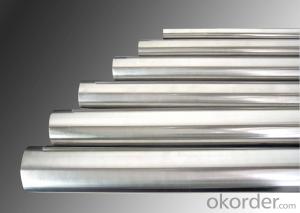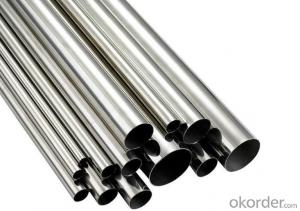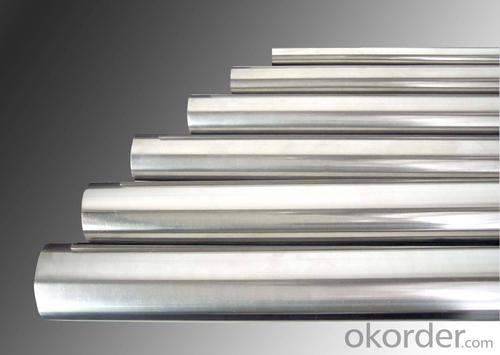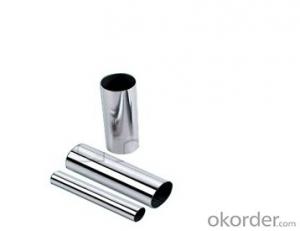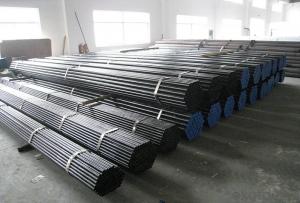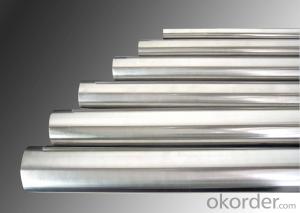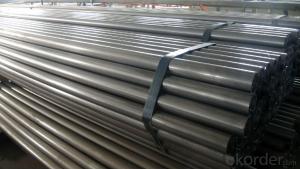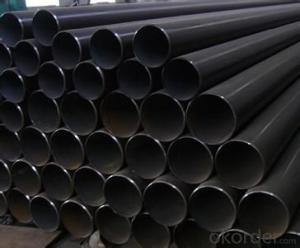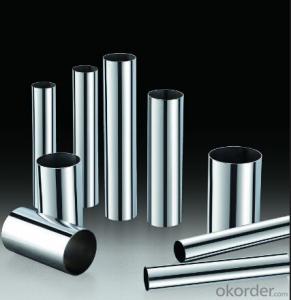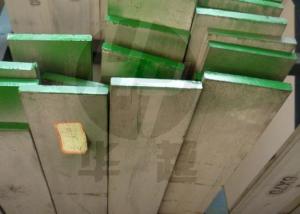Cold Drawn API Thin Wall Stainless Steel Pipe
- Loading Port:
- Tianjin
- Payment Terms:
- TT OR LC
- Min Order Qty:
- 35 m.t.
- Supply Capability:
- 5000 m.t./month
OKorder Service Pledge
OKorder Financial Service
You Might Also Like
Specification
Cold Drawn API Thin Wall Stainless Steel Pipe
1.Structure of Stainless Steel Pipe:
Seamless pipe is formed by drawing a solid billet over a piercing rod to create the hollow shell. As the manufacturing process does not include any welding, seamless pipes are perceived to be stronger and more reliable. Historically seamless pipe was regarded as withstanding pressure better than other types, and was often more easily available than welded pipe.
2.Main Features of the Stainless Steel Pipe:
• High manufacturing accuracy
• High strength
• Small inertia resistance
• Strong heat dissipation ability
• Good visual effect
• Reasonable price
3.Stainless Steel PipeSpecification:
Standard | GB, DIN, ASTM ASTM A106-2006, ASTM A53-2007 |
Grade | 10#-45#, 16Mn 10#, 20#, 45#, 16Mn |
Thickness | 8 - 33 mm |
Section Shape | Round |
Outer Diameter | 133 - 219 mm |
Place of Origin | Shandong, China (Mainland) |
Secondary Or Not | Non-secondary |
Application | Hydraulic Pipe |
Technique | Cold Drawn |
Certification | API |
Surface Treatment | factory state or painted black |
Special Pipe | API Pipe |
Alloy Or Not | Non-alloy |
Length | 5-12M |
Outer Diameter | 21.3-610mm |
Grade | 20#, 45#, Q345, API J55, API K55, API L80, API N80, API P110, A53B |
Standard | ASME, ASTM |
1) Material:20#(ASTM A 106/A53 GRB.API5LGRB,GB),45#,16Mn,10#.
2) Specification range:OD:21.3-610mm,WT:6-70mm,length:6-12m or according to the requirement of clients.
3) Excutive standards:GB,ASME API5L.ASTM A 106/A53,Despite of the above standards,we can also supply seamless steel pipe with standard of DIN,JIS,and so on,and also develop new products according to the requirements of our clients!
4) Surface:black lacquered,varnish coating or galvanized.
5) Ends:Beveled or square cut,plastic capped,painted.
6) Packing:bundles wrapped with strong steel strip,seaworthy packing.
4. Packing and Delivery:
Packaging Details: | seaworthy package,bundles wrapped with strong steel strip |
Delivery Detail: | 50-60days after received 30%TT or Original LC |
5. FAQ of Stainless Steel Pipe
A. How is the quality of your products?
Our products are manufactured strictly according to national and internaional standard, and we take a test on every pipe before delivered out. If you want see our quality certifications and all kinds of testing report, please just ask us for it.
Guaranteed: If products’ quality don’t accord to discription as we give or the promise before you place order, we promise 100% refund.
B. How about price?
Yes, we are factory and be able to give you lowest price below market one, and we have a policy that “ for saving time and absolutely honest business attitude, we quote as lowest as possible for any customer, and discount can be given according to quantity”,if you like bargain and factory price is not low enough as you think, just don’t waste your time.Please trust the quotation we would give you, it is professional one.
C. Why should you chose us?
Chose happens because of quality, then price, We can give you both.Additionally, we can also offer professional products inquiry, products knowledge train(for agents), smooth goods delivery, exellent customer solution proposals.Our service formula: good quality+good price+good service=customer’s trust
SGS test is available, customer inspection before shipping is welcome, third party inspection is no problem.
Any question, pls feel free to contact us !
6.Stainless Steel Pipe Images:
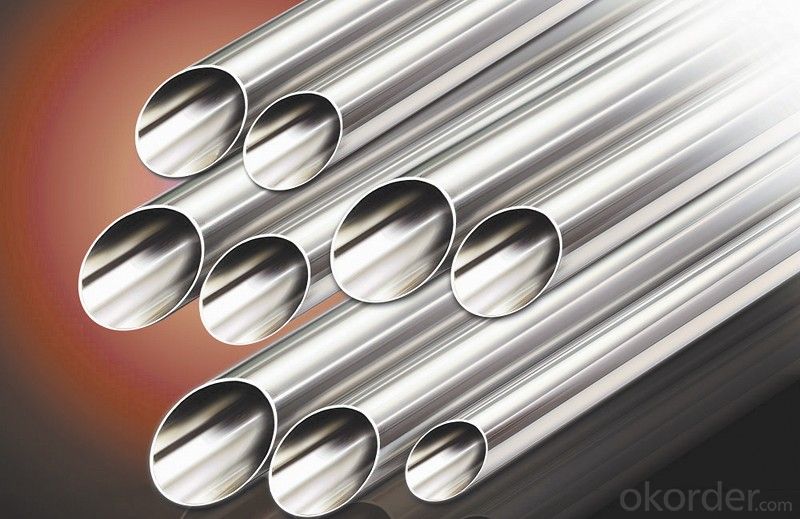
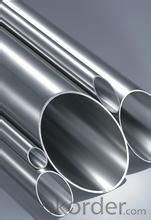
- Q: Stainless steel pipe specification 25*2 what does it mean?
- Phi 25*2 indicates that the outer diameter is 25mm and the wall thickness is 2mm. This is a small tube
- Q: What is the difference between seamless and precision stainless steel pipes?
- Seamless and precision stainless steel pipes differ in their manufacturing process and performance characteristics. Seamless stainless steel pipes are produced through the extrusion or piercing process, where a solid cylindrical billet is heated, and then a piercing rod is used to create a hollow tube. This process ensures that there are no seams or welds in the pipe, resulting in a smooth and uniform surface. The absence of seams eliminates the risk of leakage or weak points, making seamless pipes highly reliable and suitable for various applications. On the other hand, precision stainless steel pipes are manufactured through the cold-drawn or cold-rolled process. In this method, a seamless pipe is further processed to achieve precise dimensions, tolerances, and surface finishes. The precision process enhances the mechanical properties of the pipe, such as its strength, hardness, and durability. Precision pipes are commonly used in industries where tight tolerances and superior surface quality are required, such as automotive, aerospace, and medical applications. In terms of performance, seamless stainless steel pipes offer excellent corrosion resistance, high temperature resistance, and good mechanical properties. They are often used in industries such as oil and gas, chemical processing, and power generation, where reliability and strength are crucial. Precision stainless steel pipes, on the other hand, are known for their dimensional accuracy, smooth surface finishes, and superior mechanical properties. They are commonly used in precision engineering, instrumentation, and high-performance applications. In summary, the main difference between seamless and precision stainless steel pipes lies in their manufacturing process and intended applications. Seamless pipes are produced without any seams, providing excellent reliability, while precision pipes are further processed to achieve precise dimensions and superior surface quality for specific industries and applications.
- Q: How do you prevent noise transmission in stainless steel pipes?
- There exist various effective techniques for preventing noise transmission in stainless steel pipes. 1. Insulation: An effective and commonly used method for preventing noise transmission involves insulating the stainless steel pipes. To absorb and dampen sound waves, insulation materials like mineral wool, fiberglass, or foam can be wrapped around the pipes. This helps in reducing the noise transmitted through the pipes. 2. Vibration isolation: Noise transmission can also be minimized by utilizing vibration isolation techniques. This method entails the installation of flexible connectors or rubber mounts between the pipe and its supports. These isolators absorb vibrations and prevent them from being transmitted as noise through the pipe. 3. Anti-vibration pads: Another approach to prevent noise transmission is the use of anti-vibration pads. These pads are placed beneath the pipe supports to absorb vibrations and prevent their transmission as noise. They act as a barrier between the pipe and its support, significantly reducing noise transmission. 4. Acoustic lagging: The technique of applying a noise-reducing material directly onto the surface of the stainless steel pipes is known as acoustic lagging. This material, often composed of mass-loaded vinyl or rubber, acts as a barrier to block the transmission of sound waves. It effectively reduces noise transmission and can be combined with insulation for improved results. 5. Proper pipe routing: Minimizing noise transmission can be achieved by ensuring proper pipe routing. Pipes should be installed in a manner that reduces contact or proximity to other structures or surfaces that can amplify noise. Additionally, avoiding sharp bends or angles in the pipe can help in reducing noise transmission. It is important to consider that the choice of method may vary based on the specific noise issue and environment. Seeking guidance from a professional acoustic consultant or engineer is recommended to determine the most suitable solution for a particular situation.
- Q: Are stainless steel pipes more expensive than other materials?
- Stainless steel pipes are generally more expensive than other materials, but they offer significant advantages that justify their higher cost. Stainless steel pipes are known for their exceptional durability, corrosion resistance, and longevity. They can withstand extreme temperatures, harsh chemicals, and high pressure, making them suitable for a wide range of applications such as construction, plumbing, and industrial processes. Additionally, stainless steel pipes require minimal maintenance, reducing long-term costs. While the initial investment may be higher, the superior performance and extended lifespan of stainless steel pipes make them a worthwhile choice in many scenarios. Ultimately, the decision to choose stainless steel pipes should be based on the specific requirements and budget constraints of the project.
- Q: What is the maximum temperature limit for stainless steel pipes?
- The maximum temperature limit for stainless steel pipes varies depending on the grade of stainless steel used. However, in general, stainless steel pipes can withstand temperatures up to 1600°F (871°C) before experiencing significant deformation or loss of strength.
- Q: Can stainless steel pipes be etched?
- Stainless steel pipes have the capability to undergo etching, a procedure which involves eliminating a thin layer of metal from the pipe's surface to achieve a desired design or pattern. This is typically accomplished by utilizing an acid or chemical solution that selectively dissolves the exposed metal. However, it is worth mentioning that not all grades of stainless steel are equally suitable for etching. Austenitic stainless steels, specifically 304 and 316, are frequently chosen for etching purposes due to their corrosion resistance and ease of etching. The etching process can also be influenced by various factors, including the composition and thickness of the stainless steel, as well as the chosen method and conditions for etching.
- Q: How do you clean stainless steel pipes?
- To clean stainless steel pipes, there are a few methods you can use depending on the level of dirt or grime. Firstly, you can start by using warm water and a mild detergent. Mix the detergent with water and use a soft cloth or sponge to wipe down the surface of the pipes. Make sure to go in the direction of the grain to avoid scratching the steel. Rinse the pipes thoroughly with clean water and dry them with a clean, lint-free cloth. If the pipes have tougher stains or buildup, you can try using a vinegar solution. Mix equal parts of vinegar and water and apply the solution to the pipes. Allow it to sit for a few minutes to dissolve the stains, then scrub gently with a soft brush or cloth. Rinse the pipes well with clean water and dry them thoroughly. For more stubborn stains or discoloration, you can use a specialized stainless steel cleaner or polish. Follow the instructions on the product, usually applying it to the pipes and rubbing it in with a soft cloth. Again, make sure to go in the direction of the grain. Rinse the pipes thoroughly with clean water and dry them completely. It is important to note that abrasive cleaners or scrubbing pads should be avoided as they can scratch the stainless steel surface. Additionally, always test any cleaning solution or product on a small, inconspicuous area of the pipes before applying it to the entire surface to ensure it does not cause any damage or discoloration.
- Q: Can stainless steel pipes be used in the pharmaceutical industry?
- Yes, stainless steel pipes can be used in the pharmaceutical industry. Stainless steel is a popular choice for pharmaceutical applications due to its excellent corrosion resistance, high strength, and durability. It is resistant to many chemicals and can withstand high temperatures and pressures, making it suitable for transporting various pharmaceutical substances and fluids. Stainless steel pipes are also easy to clean and maintain, which is crucial in ensuring sanitation and preventing contamination in pharmaceutical manufacturing processes. Additionally, stainless steel is non-reactive and non-toxic, ensuring the integrity and quality of pharmaceutical products.
- Q: Difference between stainless steel and steel pipe
- Stainless steel (Stainless Steel) is referred to as the stainless steel, the resistance of air, steam, water and other weak corrosive medium or with stainless steel known as stainless steel; while the resistance to chemical corrosion (acid, alkali and salt chemical etching) corrosion of steel called acid resistant steel. Because of the difference in the chemical composition of the two, and make their corrosion resistance is different, ordinary stainless steel is generally not resistant to chemical medium corrosion, and acid resistant steel are generally stainless steel.
- Q: Are stainless steel pipes suitable for high-pressure steam applications?
- Yes, stainless steel pipes are suitable for high-pressure steam applications. Stainless steel is known for its excellent corrosion resistance, high temperature resistance, and strength, making it an ideal material for handling high-pressure steam. The pipes' ability to resist corrosion ensures that they can withstand the harsh conditions and prevent any leakage or failure. Additionally, stainless steel pipes can handle high temperatures without deforming or weakening, ensuring the safe and efficient transfer of steam. Overall, stainless steel pipes are a reliable choice for high-pressure steam applications due to their durability, corrosion resistance, and ability to withstand high temperatures.
Send your message to us
Cold Drawn API Thin Wall Stainless Steel Pipe
- Loading Port:
- Tianjin
- Payment Terms:
- TT OR LC
- Min Order Qty:
- 35 m.t.
- Supply Capability:
- 5000 m.t./month
OKorder Service Pledge
OKorder Financial Service
Similar products
Hot products
Hot Searches
Related keywords
